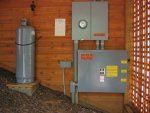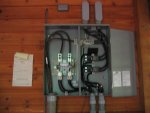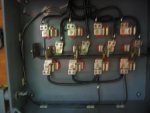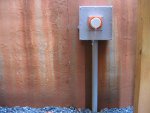Ok, So Guy, You are saying to ground the genset only and hook up the three wires to the house but do not bond the house ground to the genset? This way when the genset is running but not connected to the house it is safe but when it is hooked to the house the neutral is the floating ground? That makes sense.
And Icesythe7, I am not a pro electrician but I did spend 12 years as a building maintenance tech so I have a pretty good knowledge of electrical design. I am also very anal about reading directions and codes so I have followed this forum for years and I have followed the directions. Note the lockout switch on the panel. No I am not backfeeding my welder plug! BUT, Did you people actually watch that whole video? And did you pay attention to what was said about real life compared to the obviously conflicting codes in the NEC book? Now, That video was in 2015 I think, I do not know if the codebooks have been changed but I doubt it. I will call a buddy of mine who just retired from PSE&G after 35 years. Pretty sure he will know the proper answers.
I didn't watch the first video I try to watch recent ones like the one I linked, and genset running by itself (not connected to the house) with just extension coords for example the gen set should NOT be grounded but SHOULD be bonded, running a genset grounded while say using an extension cord if you was to have a ground that would in this scenario actually increase the risk of shock. Another scenario is if you are say using the genset at a cabin in the woods that does not have a ground system then the generator should be grounded and bonded, and lastly if connected to the house that is bonded and grounded the genset should NOT be ground and NOT bonded.
The entire goal at the end of the day is for the electricity to
1: Have a path back to the source, if there is no path back to the source in all circumstance (ground fault, short circuit, normal operation) then breakers will not trip and it is not safe
2: Ensure that there is only ONE path back to the source so that you can know exactly where the electric goes, if you have multiple paths to the source you may energize other components in the system in the event of a fault before reaching the source to clear the fault (trip the breaker)
The video I linked above uses animations and many scenarios to show the path the electric will take it is pretty decent, the bonding ordeal that comes up here often sounds complicated but it is actually extremely simple if you sit down and draw out the schematic of the circuit, simply ensure that the electric in any scenario has 1 path back to the source...easy
(Using a loop explanation I'm well aware AC is push and pull movement but for explanation)
Figure I should explain scenario 2 from above better, if you want to say run a torpedo heater off the convenience port of the genset and you ground the genset but it is not bonded in the event the black wire breaks off and you energize the torpedo heater itself, well no problem the electric goes out on black cant come back on neutral because it broke off and is laying on the frame of the heater so now it is coming back on the ground, but still has no path to the source only the ground so now you just have an electrified torpedo heater, but now you touch the torpedo heater you more than likely would not get shocked because there is no completed circuit back to the source.
Now if you ground AND bond the genset in this scenario and the same happens you now increase your risk of shock because when you touch the torpedo heater you become part of the circuit until the breaker trips, in this instance the power leaves on black comes back on green but is bonded at the genset to white so it will trip the breaker but not before briefly energizing the ground as well, so if you happen to be touching the genset and within x feet of the grounding rod you are part of the circuit and will get shocked
Now if only having the genset bonded but not grounded the electric leaves the black comes back on green is bonded to white at the genset and trips the breaker but you will not get shocked as there is no connection to ground(earth) so you can not complete the circuit, this is obviously the safest and why MOST portable gensets come bonded from the factory.






